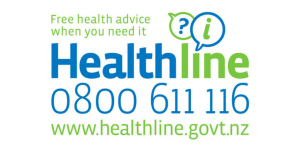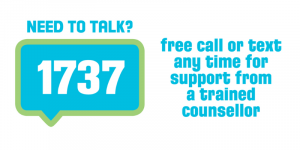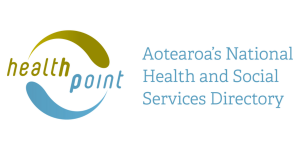Estrogel® for menopausal hormone therapy
Oestrogen gel
Key points about Estrogel®
- Estrogel® is an oestrogen-containing gel.
- It is used for menopausal hormone therapy (MHT) to ease symptoms when they are interfering with your daily life.
- Find out how to use it and possible side effects.

Estrogel is applied to the skin and slowly release the hormone oestradiol. The hormone from the gel is absorbed through your skin and into your body.
- At menopause, and during the time leading up to it (peri-menopause), your ovaries start to make less oestrogen but in perimenopause the amount produced can fluctuate a lot. These changing and declining oestrogen levels can cause symptoms such as hot flushes, vaginal dryness, and mood and sleep changes.
- Estrogel is used to ease symptoms when they are interfering with your daily life. Read more about menopause.
- It may be used for people who have early (premature) menopause for example after treatment for cancer. Read more about early menopause.
- Estrogel may also be used for osteoporosis prevention in people who are post-menopausal and who are at a high risk of fractures and unable to take other types of medicines for osteoporosis.
If you have a uterus
It’s important that you use both oestrogen and progestogen for your MHT.
- Using oestrogen gel alone can overstimulate the cells lining your uterus, causing an increased risk of cancer of the uterus lining. So if you have a uterus you will need to take progestogen together with oestrogen to reduce the risk.
- Progestogen helps to prevent the thickening of the lining and therefore reduces the risk of cancer.
- Progestogen is an artificial form of progesterone, which occurs naturally in the body. The preferred progestogen is Utrogestan because it's considered a body identical hormone therapy. It has the same chemical structure as the natural female hormone progesterone. Evidence suggests that this formulation has fewer long-term side effects.
If you’ve had a hysterectomy (your uterus has been removed)
You can use oestrogen alone and you don’t need progestogen, unless you've been diagnosed with endometriosis. If you have endometriosis, there may be some womb lining (endometrium) remaining hidden elsewhere in your body such as your bowel or bladder. Taking a continuous low dose of progesterone protects it from being stimulated by oestrogen.
When do I start using Estrogel?
- If you are already using another type of oestrogen therapy, where you have a period, finish your usual oestrogen pack before you start using Estrogel.
- If you have never used any other MHT medicines or you are switching to Estrogel from a period-free MHT product, you can start using Estrogel on any day.
Pros and cons of Estrogel?
- Pros: The risk of some side effects, such as blood clots, is lower with gel than with oestrogen tablets.
- Cons: The gel works well for many people, but it may not be a suitable option if you have sensitive skin or a skin condition where application of the gel may irritate your skin,
- EstroGel has the oestrogen hormone estradiol: The hormone is absorbed into your bloodstream and can work in hormone receptors in different parts of the body including the uterus (womb), bladder, heart, bones, skin, muscles and brain. It's applied to the skin on the arms, shoulders or mid-inner thighs. It should NOT be applied to the vulval region or breasts.
- Ovestin vaginal cream has the oestrogen hormone estriol: It's designed to work mainly in the vagina, bladder and pelvic floor. It helps improve vaginal dryness as well as urinary symptoms and pelvic floor problems. The oestrogen levels in your blood aren't raised significantly, which minimises the effect of oestrogen in other areas such as the breast or uterus. It does not need to be used with any progestogen even in women who still have a uterus. It can be used alone or with MHT. Read more about Ovestin vaginal cream.
Estrogel comes in a container with a metered dose pump
- A metered dose pump means that each pump gives the same amount of gel and the same dose.
- One pump gives 1.25 g of gel containing 0.75 mg of oestradiol.
- In Aotearoa New Zealand, Estrogel is available in the 0.06% strength.
Dose
- The usual dose is 1 or 2 pumps, as recommended by your doctor. Apply the gel once daily in the morning or evening, at about the same time each day.
- Your doctor may adjust your dose depending on your response to treatment, up to a maximum of 4 pumps in 24 hours.
- Read more below about how to apply Estrogel.
If you miss a dose
- If you forget to apply a dose and it is more than 12 hours until your next dose, apply it as soon as you remember.
- If it's less than 12 hours until your next dose, then skip the missed dose and apply the next dose at the usual time. Don't apply a double dose to make up for a forgotten dose.
- If you forget a dose you may have breakthrough bleeding or spotting.
Wash your hands with soap and water before and after applying Estrogel® .
Your doctor will tell you how many pumps of the gel you need to get the correct dose for you.
Using the pump for the first time
- When using the Estrogel pump for the first time, you'll need to prepare it for use.
- Remove the cap and press the plunger down a few times, until the gel comes out.
- Don't use the first dose of the gel from the pump. Collecting this on a tissue and throw away the used tissues carefully to avoid transfer to other adults, children or pets.
- Your pump is now ready to use.
- Note: You will only need to do this the first time you open a new pump.
Apply Estrogel to the skin on your shoulders, arms or inner thighs
- Apply Estrogel as a thin layer to a large area of your skin on your arms, from shoulder to wrist, or mid-inner thighs.
- Apply the gel to clean, dry skin. Try to use the gel at about the same time each day.
- If your dose is 2 or more pumps of gel, then apply the other doses to another suitable area.
- It's not necessary to massage in the gel.
- Allow the gel to dry completely for 5 minutes before dressing.
- Don't apply the gel to your breast or genitals, or to inflamed, broken or irritated skin.
- Bathing or swimming: Wait at least 1 hour after gel application before you have a bath, shower or swim.
- Don't apply over sunscreen or body lotion. You can apply body lotion and sunscreen over Estrogel after waiting at least one hour after application.
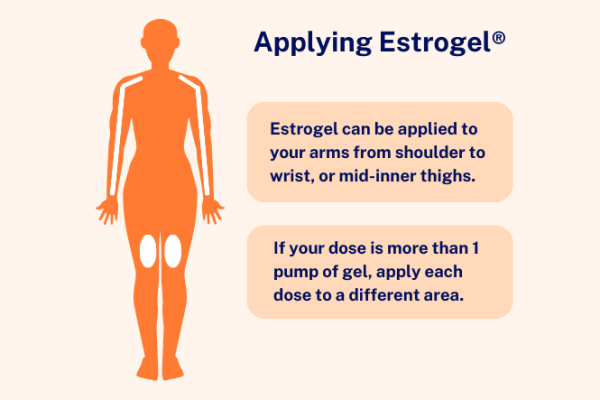
Image credit: Healthify He Puna Waiora
Avoid oestrogen transfer to other people
Oestrogen may be transferred to others through skin-to-skin contact where you applied the gel. To avoid transfer to others, it's important to:
- wash your hands straight after applying the gel
- put on clothing over the area once the gel has dried on your skin
- wear gloves if you're helping to apply oestrogen gel to another person.
It's okay to have skin-to-skin contact with others where there is no Estrogel.
Video: Estrogel – how to apply
The following video has instructions on how to apply Estrogel.
MHT is safe to use for most people if started in their 50s or for the first 10 years after the onset of menopause.
If you had an early menopause (before 45 years) you should continue treatment at least until the average age of menopause (51 years).
When assessing the risks of MHT, remember that they're not the same for everyone. Your healthcare provider will be able to discuss your individual risk with you.
- Risks vary based on how old you are, when you start MHT and how long you take it for.
- Short-term use in early menopause has fewer risks than when it's started later in menopause.
- Risks generally increase as you get older.
MHT and cancer risk
Women are often concerned about the risk of cancer when using MHT. If you're concerned, talk to your healthcare provider about your situation.
Here is some guidance.
- Breast cancer: Fear of breast cancer is a major reason why women don't use MHT. Postmenopausal women are more likely to die from heart disease or stroke than breast cancer. Overall 1 in 8 women will develop breast cancer during their lifetime. Studies suggest there's either no, or minimal risk of breast cancer when using oestrogen-only MHT. There is a greater risk of breast cancer from two alcoholic drinks daily or being significantly overweight. Breast cancer risk is lower with oestrogen-only MHT compared with oestrogen plus progestogen. The risk increases the longer you take MHT and decreases after stopping it. Some types of progestogens such as Utrogestan have lower risk. Read more about breast cancer risk(external link).
- Endometrial cancer: Oestrogen-only MHT increases the risk if you have a uterus, because oestrogen stimulates the endometrial lining. That’s why progestogen is added to protect your uterus. Combined MHT (oestrogen + progestogen) protects against endometrial cancer, when used continuously.
- Ovarian cancer: There is a very low risk that MHT increases the risk of ovarian cancer. The absolute risk of ovarian cancer associated with MHT use is low, with about 1 additional case per 1,000 women using MHT for 5 years.
MHT after treatment for cancer
Women often have concerns about starting MHT after having cancer treatment. Your suitability to start MHT depends on the type of tumour you have.
- Cervical, vaginal and vulval cancers: Using MHT is generally suitable if you’ve had these cancers, as they're not considered hormone responsive cancers. This means these types of cancers don't rely on hormones (such as oestrogen or progesterone) to grow or spread.
- Endometrial cancer: MHT is reasonable for those who have had surgery (removal of uterus and both ovaries) for low-risk endometrial cancer to use oestrogen replacement, with either the patch, gel or tablets. Progesterone is rarely required – your gynaecologist will advise you. Note: You will not need progestogen because your uterus has been removed.
- Ovarian cancer: MHT treatment depends on whether you have had surgery to remove your uterus. In some types of ovarian cancers, MHT can be considered after weighing up the risk and benefits. It's important you discuss this with your gynaecology oncologist before starting MHT
- Breast cancer: For women who have had hormone receptor-positive breast cancer, MHT is not usually recommended. Non-hormonal treatments are preferred.
Every person is different and the length of time you'll have menopausal symptoms is unknown.
- If you had an early menopause (before 45 years) you should continue treatment at least until the average age of menopause (51 years).
- It’s important to have regular check-ups with your doctor to assess whether ongoing oestrogen is right for you.
- Most people stop taking it after a few years, when their symptoms resolve. It's usually best to reduce menopausal hormone therapy gradually rather than stopping it suddenly. This may reduce the risk of menopause symptoms returning.
- Current research suggests that oestrogen can be taken long term and there is no recommended ‘stop’ time, however after five years of MHT or after your mid 50’s, the pros and cons of MHT should be discussed with your healthcare provider.
Like all medicines, oestrogen gel can cause side effects, although not everyone gets them. If you're concerned about any symptoms you think might be related to your medicine, talk to your healthcare provider. The following information offers some guidance but doesn't include all possible side effects.
Common side effects
Tell your healthcare provider if they bother you.
- Headaches.
- Breast tenderness or pain.
- Feeling sick (nausea).
- Mood changes.
- Weight changes.
Tell your healthcare provider immediately or phone Healthline free on 0800 611 116 if these occur
- Signs of deep vein thrombosis (DVT) such as pain, redness or swelling in one of your legs, usually in your calf.
- Signs of problems with your liver such as tummy pain, your skin and eyes turning a yellow colour, itchy skin, dark coloured pee, pale coloured poo.
- A lump or changes in your breasts, especially dimpling of the skin, changes in the nipple or any lumps you can see or feel.
- Any changes in vaginal bleeding after you have been taking oestrogen for more than a few months.
Phone 111 for an ambulance or go to your nearest accident and emergency (A&E) clinic if these occur
- Signs of an allergic reaction such as itchy skin, and rash, swollen lips or tongue, problems breathing, like a tight chest or shortness of breath.
Read more about medicines and side effects and reporting a reaction you think might be a side effect.
Estrogel®(external link) Consumer Medicine Information (CMI), Medsafe, NZ
Brochures
Medicines and side effects [PDF, 91 KB] Healthify He Puna Waiora, NZ, 2024
5 questions to ask about your medications(external link) Health Quality and Safety Commission, NZ, 2019 English(external link), te reo Māori(external link)
References
- Estradiol(external link) New Zealand Formulary
- Estrogel®(external link) Data Sheet, Medsafe, NZ
Brochures
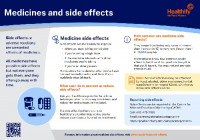
Medicines and side effects
Healthify He Puna Waiora, NZ, 2024
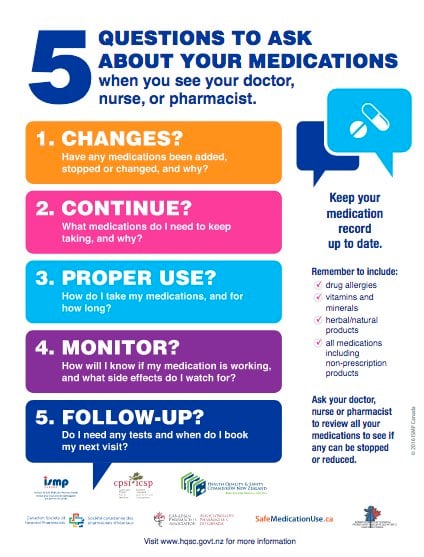
Health Quality and Safety Commission, NZ, 2019 English, te reo Māori
Credits: Sandra Ponen, Pharmacist, Healthify He Puna Waiora. Healthify is brought to you by Health Navigator Charitable Trust.
Reviewed by: Angela Lambie, Pharmacist, Auckland; Dr Patricia Whitfield, MBChB, FRACP, Wellington
Last reviewed:
Page last updated:


